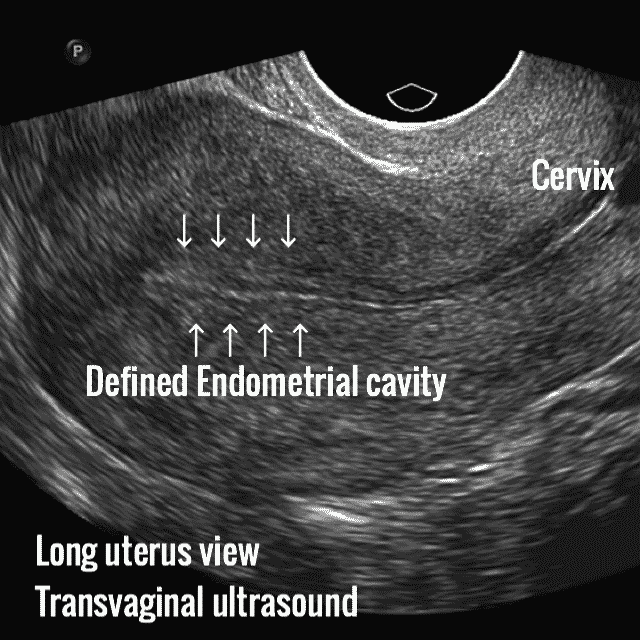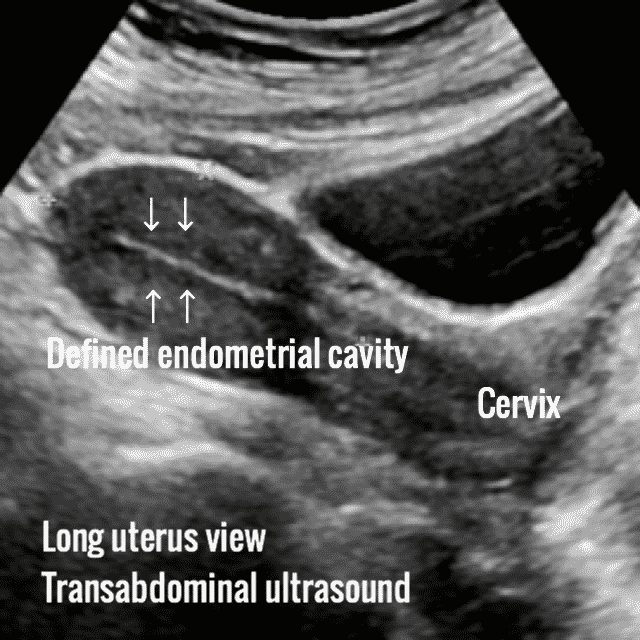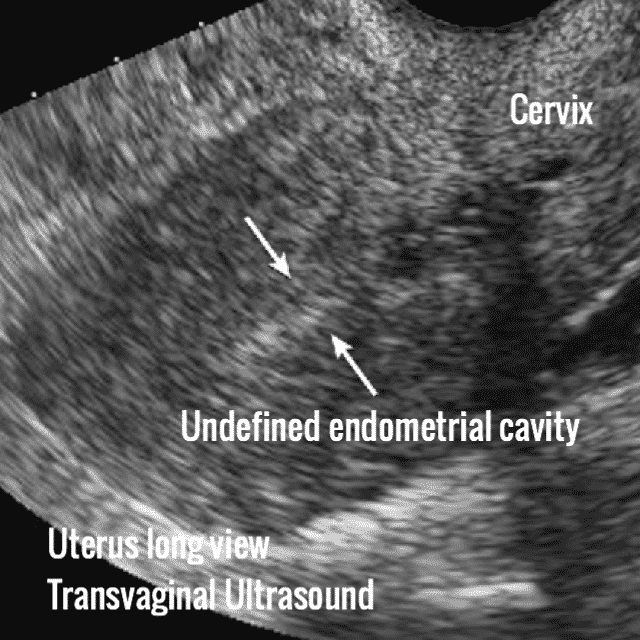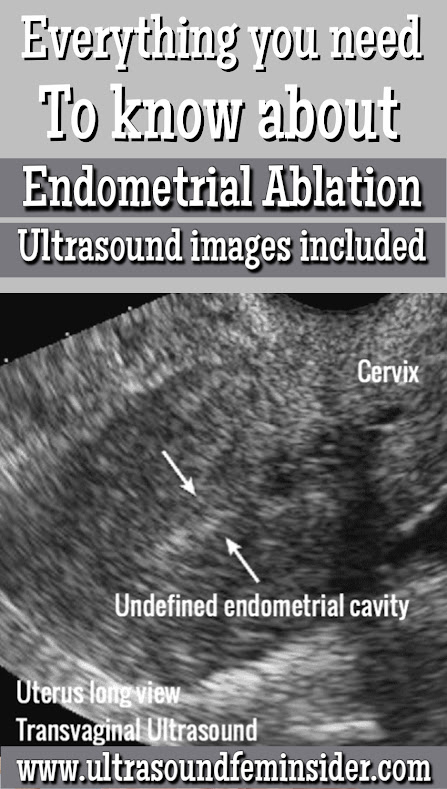Endometrial ablation is one of the most used outpatient Non-surgical procedures to treat abnormal profuse bleeding. But there are pros and cons that you should know before performing it. If you are interested in this topic, this post is going to give you valuable information. As usual, I am going to include ultrasound images.
What is endometrial ablation?
Endometrial ablation is the procedure, that is done to destroy the cells of the uterine cavity known as endometrium. By destroying these endometrial cells, a considerable decrease in the amount of blood can be achieved during the monthly periods.
Who are perfect candidates for endometrial ablation?
Patients who are still in the reproductive stage, and that are not yet in menopause. But have already finished having family. Who are suffering from profuse bleeding every month, without showing any improvement with conventional hormonal treatments, this is the profile of a woman who can be benefited from this procedure.
Who are the patients that can’t have an endometrial ablation?
Patients who has:
- Disorders of the uterus or endometrium
- Endometrial hyperplasia
- Cancer of the uterus
- Recent pregnancy or desire of future pregnancies
- Current or recent infection of the uterus
- Menopausal patients
Sharing is caring!
How is the endometrial ablation performed?
The endometrial ablation is not a surgery. Your doctor doesn’t need to make any surgical cuts. Instead, he will insert thin tools through your vagina, then the cervical opening, all the way to the uterine lining or cavity. Now, let’s take a look to the types of endometrial ablation that exist.
Most commonly used methods to perform endometrial ablation:
- Radiofrequency: A thin probe is inserted into the uterine cavity through the cervix. The tip of the probe expands into a mesh-like device that sends radiofrequency energy into the lining. The energy/heat destroy the cavity. Immediately suction is applied to remove endometrial tissue.
- Freezing: A thin probe is inserted into the uterine cavity. The tip of the probe freezes the uterine lining. Ultrasound is used to help guide the procedure. This procedure is known as “cryoablation.”
- Heated fluid: Fluid is inserted into the uterus through a hysteroscope, a slender, light-transmitting device. The fluid is heated and stays in the uterus for about 10 minutes. The heat of the fluid destroys the lining.
- Heated balloon: A balloon is placed in the uterus with a hysteroscope.
Heated fluid is put into the balloon. The balloon expands until its edges touch the uterine lining. The heat destroys the endometrial tissue. - Microwave energy: A special probe is inserted into the uterus through the cervix. The probe applies microwave energy to the uterine lining, which destroys it.
- Electrosurgery: Electrosurgery is done with a resectoscope. A resectoscope is a slender telescopic device that is inserted into the uterine cavity. this device has an electrical wire loop, roller-ball, or spiked-ball tip that destroys the uterine lining. This last method usually is done in an operating room with general anesthesia. It is not as frequently used as the other methods.
The type of anesthesia required depends upon the method used, while some procedures can be performed with minimal anesthesia during a regular office visit. Others may be performed in an outpatient surgery center.
Ultrasound images related to endometrial ablation.



Endometrial ablation side effects.
After the procedure some side effects may be present for a few days, even for a few weeks. Here you have the most frequent ones.
- The most frequent of all is cramping, as if you had the period. This cramping will last at least 1 to 2 days.
- Watery bloody discharge, which can last a few weeks. The discharge may be heavy for 2–3 days after the procedure and then starts getting slowly better.
- Frequent urination for the first 24 hours.
- Nausea.
- Tear or damage to the cervical opening (the opening to the uterus).
- Some women may experience regrowth of the endometrium and need further surgery in the future.
- Among the patients who have endometrial ablation, there is a large number of them who report suffering from chronic pelvic pain, and or severe cramping with periods.
Endometrial ablation recovery.
Recovery after an endometrial ablation procedure is generally short. Many women report returning to their regular daily routine in as soon as 1 week. However, to accelerate the recovery, there are some indications that you must follow, such as:
- You should avoid sex, the use of tampons, or douches for a few days.
- Limit your physical activity, and especially avoid carrying heavy things immediately after the procedure.
- If you want to take pain medicine, you should exclude aspirin, as it may cause more bleeding. But there are other over-the-counter options that you can take. You must check with the doctor.
If you have any of these signs, call your doctor right away:
- Strong-smelling discharge from your vagina
- Fever
- Chills
- Intense cramping or stomach pain
- Heavy bleeding or bleeding that doesn’t stop 2 days after your ablation
- Trouble peeing.
Risks associated with endometrial ablation?
Like any surgical procedure, endometrial ablation also has risks.
- There is a very small risk of infection and bleeding right after the procedure.
- The device used to do the ablation may cause perforation on the uterus of intestines.
- With some methods, there is a risk of burns to the vagina, vulva, and bowel as well.
- Rarely, the fluid used to expand your uterus during electrosurgery may be absorbed into your bloodstream. This condition can be serious.
Other posts you might enjoy!
Pelvic pain in women. Role of ultrasound diagnosing pelvic pain.
Ovaries, hormonal cycles and common cysts.
All about Polycystic ovarian syndrome or PCOS.
Adenomyosis, symptoms, causes and treatment.
Conclusions about Endometrial Ablation.
Again, an endometrial ablation is a procedure your doctor might consider if you bleed between your menstrual periods, have a heavy flow, or have periods that last a long time. If medicine doesn’t help, your doctor might suggest endometrial ablation. It can curb the bleeding or stop it completely.
The great message and purpose of this article is to inform you and for you to know all the pros and cons that come with this procedure. Of course, choosing a trained and experienced gynecologist who can perform the procedure with minimal risks is also very important. I hope this article was helpful to you, share this information with other women who might need some guidance.
Zadi, xo
Disclaimer: This post is not intended to diagnose, treat, prevent, or cure any disease. For proper medical attention, please visit your physician.











Wow, that is interesting I learned a lot
Thank you Denise
[…] Endometrial ablation, all you need to know. […]
[…] Endometrial ablation, all you need to know. […]
Hello there! I could have sworn I’ve been to this site before but after reading through some of the post I realized it’s new to me. Anyways, I’m definitely delighted I found it and I’ll be bookmarking and checking back often!
There is apparently a bundle to know about this. I think you made certain good points in features also.